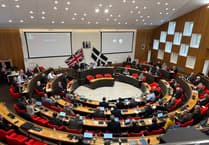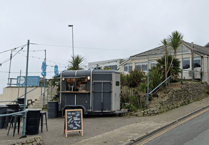THERE are growing concerns that plans to redevelop and modernise Falmouth Docks could lead to hundreds of thousands of tonnes of toxic sludge being dumped at sea.
Environmental campaigners fear dredging will also have a detrimental impact on the unique marine habitat within the Fal Estuary, with one oyster expert saying it could lead to a ‘catastrophic disaster’.
Falmouth Docks and Engineering Company (FDEC) and A&P Falmouth Ltd have applied to Cornwall Council for planning permission, and to the Marine Management Organisation (MMO) for a licence, to build new wharves, create a new area to build floating offshore windfarms and enhance berth capacity for alongside docking for improved cruise and cargo capacity.
If approved, the £150-million proposal could see up to 200,000 passengers visit the port every year by 2030, which, in turn, could boost the local economy by an additional £13-million and create more than 350 jobs.
The work would involve partial demolition of existing wharf structures and the demolition of eight buildings currently on the site. More controversial is the dredging around the wharfs to allow cruise ships to dock alongside.
Environmental campaigners are worried this would see around 850,000 tonnes of toxic waste from the docks dredged and dumped at out at sea. They are calling on Falmouth Town Council and the MMO to refuse the marine licence unless up-to-date surveys are carried out, a full ‘appropriate assessment’ is undertaken and priority habitats like maerl are guaranteed protection. The town council recommended approval of the planning application in April.
Penryn-based environmental campaigner Sophie Miller said: “The dredging is framed as part of a ‘modernisation of the docks’ that will enable Falmouth to support larger cruise ships and military contracts as well as floating offshore wind (FLOW) deployment in the Celtic Sea – a big UK government priority – saying that it will create ‘green jobs’ in renewables supply chains and that it is part of a transition away from traditional/heavy industry.
“But larger cruise ships are far from ‘green infrastructure’ – they mean significantly more air pollution for Falmouth (one cruise ship ticking over has the same emissions as a million cars), increased sewage discharge into our local sea and more carbon emissions locally.
“Also there’s no evidence provided that FLOW-related infrastructure even needs a deeper harbour. Offshore wind components can and are transported on vessels with shallower drafts than the ultra-deep cruise liners the dredge is actually designed to accommodate.”
She added: “Their claim of environmental benefit is therefore inaccurate. They are using FLOW as a ‘green wash’ to push through dredging that serves the cruise industry.”
Those opposed to the scheme say the dredge site lies on the edge of the Fal & Helford Special Area of Conservation (SAC), a legally protected marine area. The waters are home to rare maerl beds, a fragile, coral-like algae which provides shelter for many marine species. “Maerl grows at just one millimetre per year. Once buried by silt, it dies,” added Ms Miller.
“The developers admit maerl has been recorded within 200 metres of the dredge zone,” she said. “Yet they have not done the modern surveys we would expect for a project of this scale. Instead of using underwater cameras or sonar mapping, they relied on just five seabed samples and old maps from more than a decade ago. It’s like trying to judge the health of a whole forest by checking five trees.”
The campaigners say the risks don’t end there. Ms Miller said: “The dredging from the docks contains decades of toxic contaminants and will release plumes of noxious fine sediment that will likely contain copper, mercury and arsenic that were used as anti-fouling biocides on boats.
“Their models say only a few millimetres will settle nearby, but they ignore what happens when storms stir things up or how silt can clog and smother delicate habitats. Even a thin layer is enough to kill live maerl.”
Chris Ranger, a Fal oyster fisherman and merchant, added: “I am surprised to see another application to dredge the Falmouth Docks, albeit a smaller amount of dredging: 850,000 tonnes compared to the old 1.25m tonnes, but the concern of the currently dormant toxic heavy metals being re-suspended during the dredging, is just the same.
“There is great concern for unique marine habitat within the Fal Estuary, including probably the last natural native oyster biomass forming a significant part of the 5-15 per cent left globally, and then there is the eel grass that actually has presidency over the native oysters, as well as the old maerl beds that prevented the last application from going ahead.”
He added: “I get that the docks needs to redevelop, but in all honesty, it’s their toxic paint that was just dumped over the side, or poorly managed for decades, that is their own curse now. No amount of precautionary measures will ever stop the suspended sediment from heading up and down the estuary, and they still want to dump it in Gerrans Bay, another catastrophic disaster for marine life.”
A&P and their planning agents were contacted for a response to the concerns. While not yet commenting on the issues raised by the campaigners, Drystan Jones, A&P’s director of port development in Falmouth, said the company has been running a series of site visits to discuss any concerns with the public. He said he would be pleased to arrange a meeting with the people who have spoken to us.
He told a meeting of Falmouth Town Council’s planning committee earlier this year that this scheme was different from previous proposals as dredging would only be focused around the wharf structures rather than the whole channel to allow cruise ships to dock alongside.
Mr Jones said they had been working with Natural England and Cornwall Council, which had given nearly one million pounds for an environmental impact assessment which was completed in early 2025.
“I think the important thing to say is that we’re working with those stakeholders and the community including our user group and the Falmouth Harbour Commissioners and other statutory organisations as well,” he added. “We are very keen that the scheme is not causing friction within the community.”
Members of the public can comment on the marine licence application by going to the online MMO Public Register and searching for MLA/2025/00157 by September 4.
-has-filed-a-planning-application-with-both-Cornwall-Counci.jpeg?trim=0,89,0,172&width=752&height=500&crop=752:500)




Comments
This article has no comments yet. Be the first to leave a comment.